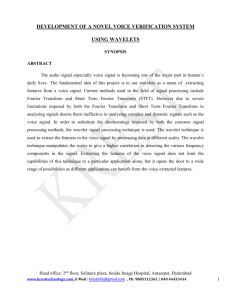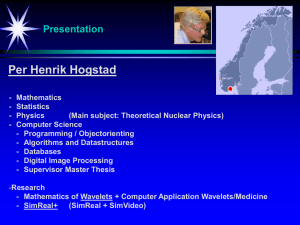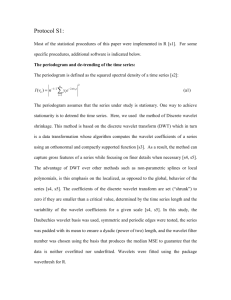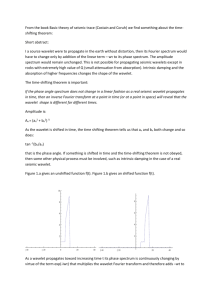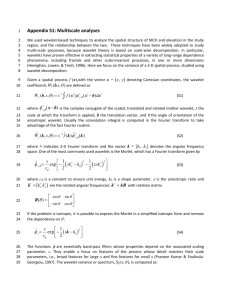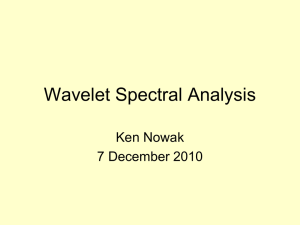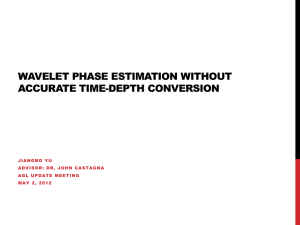12. Wavelet Analysis
advertisement
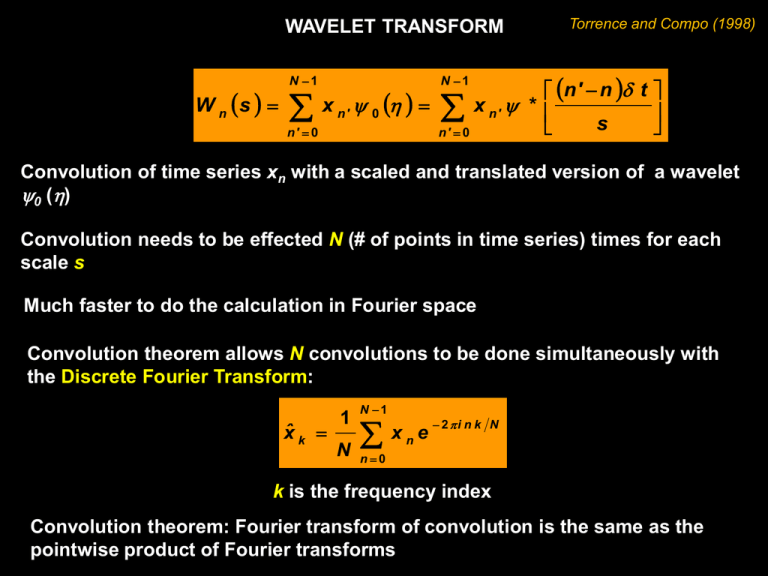
WAVELET TRANSFORM Torrence and Compo (1998) n' n t W n s x n ' 0 x n' * s n' 0 n' 0 N 1 N 1 Convolution of time series xn with a scaled and translated version of a wavelet 0 () Convolution needs to be effected N (# of points in time series) times for each scale s Much faster to do the calculation in Fourier space Convolution theorem allows N convolutions to be done simultaneously with the Discrete Fourier Transform: xˆ k 1 N N 1 xne 2i n k N n0 k is the frequency index Convolution theorem: Fourier transform of convolution is the same as the pointwise product of Fourier transforms WAVELET TRANSFORM n' n t W n s x n' * s n' 0 N 1 xˆ k 1 N N 1 x n e 2i n k N n0 t ˆ s Fourier transform of s Inverse Fourier transform of Wˆ xˆ kˆ W n s N 1 is Wn (s) i n t xˆ k ˆ * s k e k k 0 With this relationship and a FFT routine, can calculate the continuous wavelet transform (for each s) at all n simultaneously k N 2 k N t : k 2 2 k N : k N t 2 N 1 W n s xˆ k ˆ * s k e k 0 1 4 i k n t e i 0 e 2 2 1 4 H e s s 0 2 2 ˆ 0 0 To ensure direct comparison from one s to the other, need to normalize wavelet function 2 s ˆ s k t 12 2 ˆ 0 s k m m i m! 2 m ! 1 i 2 m 1 m H s e m m 2 m 1! s ˆ 0 0 ˆ 0 ' d ' 1 2 1 i.e. each unscaled wavelet function has been normalized to have unit energy 0 0 m 1 d m 1 d m 2 m e 2 2 ˆ 0 and at each scale (N is total # of points): N 1 ˆ s k 2 N k 0 Wavelet transform is weighted by amplitude of Fourier coefficients xˆ k and not by ˆ ˆ 0 i m m 1 2 s m e s 2 2 W n s N 1 i n t xˆ k ˆ * s k e k k 0 Wavelet transform Wn(s) is complex because wavelet function is complex Wn(s) has real and imaginary parts that give the amplitude and phase and the wavelet power spectrum is |Wn(s)|2 for real the imaginary part is zero and there is no phase W n s for white noise 2 2 2 N xˆ k W n s 2 Normalized wavelet power spectrum is W n s 2 xˆ k N 2 2 2 for all n and s Seasonal SST averaged over Central Pacific W n s 2 2 Power relative to white noise Considerations for choice of wavelet function: 1) Orthogonal or non-orthogonal: Non-orthogonal (like those shown here) are useful for time series analysis. Orthogonal wavelets – Haar, Daubechies 2) Complex or real: Complex returns information on amplitude and phase; better adapted for oscillatory behavior. Real returns single component; isolates peaks 3) Width (e-folding time of 0): Narrow function -- good time resolution Broad function – good frequency resolution 4) Shape: For time series with jumps or steps – use boxcar-like function (Haar) For smoothly varying time series – use a damped cosine (qualitatively similar results of wavelet power spectra). 2s ˆ 0 0 s 2 ˆ 0 0 2s ˆ 0 0 2s ˆ 0 0 Cone of Influence 2s Morlet & DOG s 2 Paul Seasonal SST averaged over Central Pacific W n s 2 2 Relationship between Wavelet Scale and Fourier period Write scales as fractional powers of 2: J log 2 N t j j , j 0 ,1, , J s0 j smallest resolvable scale should be chosen so that the equivalent Fourier period is ~2 t largest scale W n s s j s0 2 j ≤ 0.5 for Morlet wavelet; ≤ 1 for others 2 2 N = 506 t = 0.25 yr s0 = 2 t = 0.5 yr j = 0.125 J = 56 57 scales ranging from 0.5 to 64 yr Relationship between Wavelet Scale and Fourier period 0 Can be derived substituting a cosine wave of a known frequency into W n s N 1 xˆ k ˆ * s k e 4 s 0 2 0 2 ˆ 0 1 . 03 s : 0 6 i k n t k 0 ˆ 0 0 and computing s at which Wn is maximum 0 2m 1 1 . 396 s : m 4 4 s ˆ 0 2 s m 12 3 . 974 s : m 2 2 . 465 s : m 6 ˆ 0 0 Seasonal SST averaged over Central Pacific How to determine the significance level? 1 . 03 s : 0 6 W n s 2 2 3 . 974 s : m 2 Because the square of a normally distributed real variable is 2 distributed with 1 DOF xk W n s 2 2 is 2 2 should be 2 2 At each point of the wavelet power spectrum, there is a 22 distribution For a real function (Mexican hat) there is a 12 distribution Distribution for the local wavelet power spectrum: W n s 2 2 1 2 Pk 2 2 Pk is the mean spectrum at Fourier frequency k, corresponding to wavelet scale s SUMMARY OF WAVELET POWER SPECTRUM PROCEDURES 1) Find Fourier transform of time series (may need to pad it with zeros) 2) Choose wavelet function and a set of scales 2 s ˆ s k t 3) For each scale, build the normalized wavelet function 4) Find wavelet transform at each scale W n s N 1 xˆ k ˆ * s k e 12 i k n t k 0 5) Determine cone of influence and Fourier wavelength at each scale 6) Contour plot wavelet power spectrum 7) Compute and draw 95% significance level contour ˆ 0 s k

